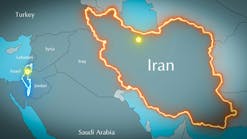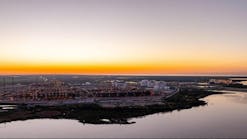G. Alan PetzetNonproducing Costa Rica has awarded its first private contract for hydrocarbon exploration and production in more than 30 years to a private New Orleans area independent.
Exploration Editor
MKJ Xploration Inc., Metairie, La., won rights to blocks 2, 3, 4, and 12 in the Limon basin on Costa Rica's Caribbean coast. The four blocks, part of the October 1997 licensing round, total 1,391,489 acres.
The blocks carry a maximum 6 year exploration period, including 3 years primary term with three 1 year extensions, and a consecutive 20 years for production.
Fiscal terms include a 15% royalty to the government, subject to a 30% maximum tax rate, and no other direct government participation. MKJ bid a reinvestment percentage of 5%, meaning that 5% of any profits will be spent on community improvements.
The terms appear to rank with the 5-10 most favorable world fiscal systems, said Eric H. Conrad, MKJ president. Costa Rica's minister of Environment and Energy signed the concession on June 22.
MKJ, which is seeking exploration partners, is required to gather 96 sq km of 3D seismic data, drill 3,000 m of exploratory footage, spudding by the end of the second year, and spend a minimum $2.3 million overall.
Elf Aquitaine had the last Costa Rican area to be licensed, in 1976. Since then the country has had associations with Pemex and Petro-Canada.
The ministry's hydrocarbon group and the Direccion General de Hidrocarburos hope to hold a second licensing round later this year to re-offer the country's 22 remaining blocks (see map, OGJ, May 12, 1997, p. 76).
The blocks are MKJ's first operated non-U.S. venture, although the company participated in an Umm al Qaiwain concession in the 1980s.
Limon geology
The Limon basin is a Cretaceous and Tertiary backarc basin with three parallel thrust and fold systems. Two main structures are sub-thrust basement features with possible overlying Cretaceous reef development.MKJ has identified two 30,000-60,000 acre anticlines based on interpretation of 2,200 miles of modern 2D seismic data and magnetic, gravity, and surface geology data.
Main reservoir targets are Middle Cretaceous rudistid reef limestones. The reefs are underlain and potentially sourced by organically rich Middle Cretaceous black shales that are stratigraphic equivalents to the prolific La Luna/Querecual/Villeta oil source rocks in the Magdalena, Llanos, Maracaibo, and Maturin basins of Colombia and Venezuela.
Total organic carbon in the Loma Chumico shales in Costa Rica is generally 10-20% and ranges as high as 40-50%, Conrad said. The South American source rocks contain an average 4% TOC. The Loma Chumico/La Luna oil source rocks correlates with the Cretaceous oceanic anoxic event OAE-2.
Geology south of Block 2 becomes highly complex, and drilling depths for Cretaceous targets likely extend to 20,000-25,000 ft there, Conrad said.
The former Union Oil Co. of California drilled the Cocoles 2 well south of Block 2, on present day Block 1, in 1957. Tested at the rate of 1,800 b/d of 46° gravity oil from 4,900 ft (Oligocene), it produced only about 10 days as water cut increased.
Just northwest of that well is the San Jose well (6), which Pemex drilled to 15,749 ft for Recope in 1983. It is the deepest penetration on Costa Rica's Caribbean margin.
Structures, depths
MKJ's onshore structure covers 24,000 acres with 3,000-4,000 ft of closure. It is a thrust faulted surface anticline with active oil and gas seeps that indicate deeper oil and gas generation and vertical migration. Reserves potential is 1 billion bbl of oil at 8,000-12,000 ft.The onshore/offshore structure covers 56,000 acres with 2,500 ft of closure. Water depth ranges to 1,600 ft. The structure is a subthrust basement anticline with an indicated overlying massive Middle Cretaceous rudistid reef complex at 8,500-12,000 ft.
Reserve potential is 2.2 billion bbl for the Cretaceous reef and 500 million bbl (or 2 tcf of gas and 50 million bbl of condensate) for the overlying Oligocene-Miocene barrier reef at 5,000 ft. The Miocene reef has associated seismic bright spots and flat spots that may indicate hydrocarbon saturation.
A pronounced high temperature thermal anomaly and seismic velocity anomaly are associated with the structure's crest.
The vertical seals, Uscari shales, are moderately overpressured (0.65 psi/ft). The velocity anomaly, which could result from vertical leakage from an underlying reservoir gas cap, covers 12,000 acres.
No well drilled in the Limon basin has penetrated rocks older than Paleocene (basal Tertiary), although multiple wells have tested 30-46° gravity sweet crude from shallower Tertiary formations.
Oil and gas seeps are common on the country's Carib- bean coast, and geochemical studies indicate a high geo- thermal gradient with indicated deeper oil and gas generation and migration.
Reserve potentials are 1-3 billion bbl for Cretaceous reef limestones and 500 million bbl for shallower Tertiary reef as a secondary objective, Conrad said.
MKJ said a modern, 16,400 ft capacity land rig is available in the area. A power station and RECOPE's 15,000 b/d Limon refinery are near the center of the four contiguous blocks. The refinery processes mostly Mexican Mayan and some Venezuelan crude. A national preserve area separates Block 3 into two parts.
Copyright 1998 Oil & Gas Journal. All Rights Reserved.

